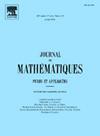超kähler流形的抛物自同构
IF 2.1
1区 数学
Q1 MATHEMATICS
引用次数: 1
摘要
超kähler流形M的抛物自同构是一个作用于H2(M)的非半单拟单势线性映射的全纯自同构。我们证明了一个保持拉格朗日纤维化的抛物型自同构遍历地作用于几乎所有的纤维。对于满足hyperkähler-SYZ猜想的流形,不变拉格朗日fibration的存在是自动的;这包括所有已知的超kähler流形的例子。当存在两个保留两个不同拉格朗日fibration的抛物自同构时,可以得出它们生成的群遍历地作用于M。我们的结果推广了S.Cantat对K3曲面的结果。本文章由计算机程序翻译,如有差异,请以英文原文为准。
Parabolic automorphisms of hyperkähler manifolds
A parabolic automorphism of a hyperkähler manifold M is a holomorphic automorphism acting on by a non-semisimple quasi-unipotent linear map. We prove that a parabolic automorphism which preserves a Lagrangian fibration acts on almost all fibers ergodically. The existence of an invariant Lagrangian fibration is automatic for manifolds satisfying the hyperkähler SYZ conjecture; this includes all known examples of hyperkähler manifolds. When there are two parabolic automorphisms preserving two distinct Lagrangian fibrations, it follows that the group they generate acts on M ergodically. Our results generalize those obtained by S. Cantat for K3 surfaces.
求助全文
通过发布文献求助,成功后即可免费获取论文全文。
去求助
来源期刊
CiteScore
4.30
自引率
0.00%
发文量
84
审稿时长
6 months
期刊介绍:
Published from 1836 by the leading French mathematicians, the Journal des Mathématiques Pures et Appliquées is the second oldest international mathematical journal in the world. It was founded by Joseph Liouville and published continuously by leading French Mathematicians - among the latest: Jean Leray, Jacques-Louis Lions, Paul Malliavin and presently Pierre-Louis Lions.

 求助内容:
求助内容: 应助结果提醒方式:
应助结果提醒方式:


